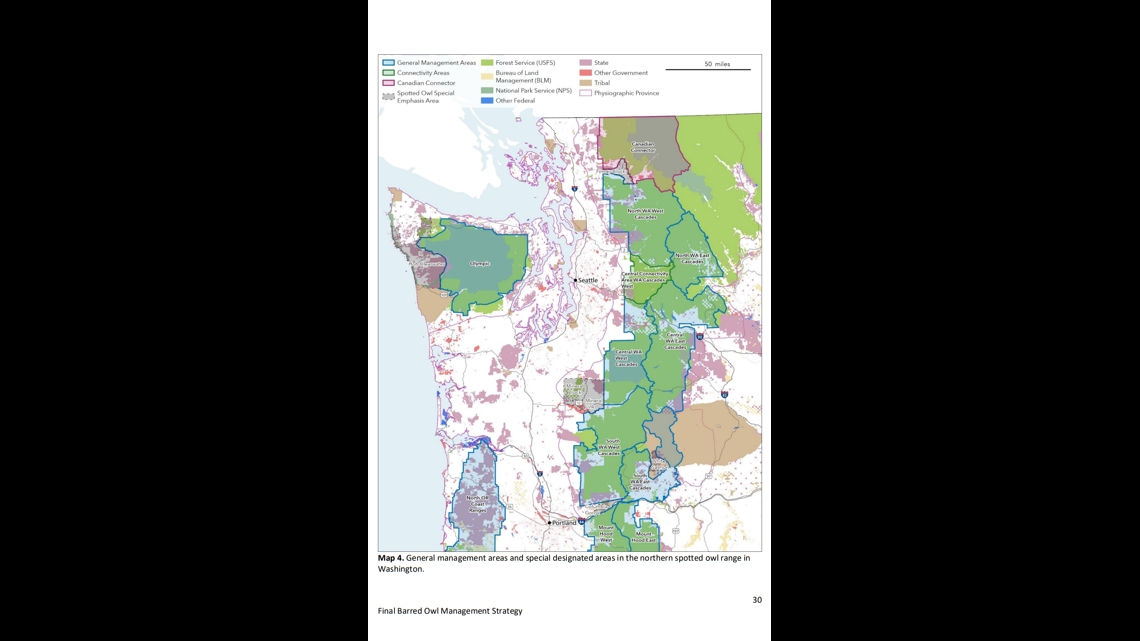WASHINGTON, USA — A controversial plan to save one species in Washington state by killing another is set to begin soon.
The Proposed Barred Owl Management Strategy developed by the U.S. Fish and Wildlife Service (USFWS) is officially being implemented in Washington, Oregon and California.
"If we do nothing, we won't have spotted owls," said Bridget Moran, Deputy State Supervisor, USFWS Oregon Office. "If we do something, we will have both.”
According to USFWS - the removal or killing of barred owls, an invasive species, could start as early as this fall, but will have full implementation by next spring.
According to the strategy that was based on years of research and studies - about 450,000 barred owls would be shot and killed over three decades
Public hunting of barred owls will be prohibited.
“All removal has to be done by trained removal specialists," said Robin Bown, leader of barred owl management strategy development. "Where firearms are not allowed or contraindicated – barred owls may be trapped and euthanized.”
Megaphones blaring recorded owl calls would be used to lure barred owls. They will be shot with shotguns and their carcasses would be buried on site.
“We don't take this lightly," Moran said. "We have a responsibility to recover the spotted owl, but we're conservation biologists. So that's very challenging for us to come to this decision.”
Other conservationists recognize this difficult situation.
"It's a terrible decision to have to make. No one wants to see the spotted owl go out," said Greg Costello, former retired executive director of Wildlands Network.
Costello said he disagrees with the USFWS strategy to remove barred owls.
"We've made the barred owl the villain here and it's not. We're the villain," Costello said. "We're the ones who have destroyed all this habitat and we can't make up for that on the lives of the barred owl."
Concerns over the spotted owl’s vanishing old-growth forest habitat and invasive species competition date back to 1990 when they were listed as threatened under the Endangered Species Act.
"They’re intelligent. They have emotional feelings. They have social structures. They communicate," Costello said. "I think it's high time that we start considering the fact that these are sentient beings we are impacting."
Ultimately, Costello said killing barred owls will not save spotted owls.
"Barred owls are everywhere in our Northwest forests This isn't like an island where you can kill off a population and more are not coming in," Costello said. "Barred owls will move into these areas... just as fast as they're shot, they're going to keep coming."
According to USFWS, the removal strategy would reduce North American barred owl numbers by less than one percent annually.
A menace to the spotted owl's survival
Aside from barred owls killing spotted owls when moving into their territories - USFWS officials said its the barred owl's diet that not only threatens the spotted owl but other West Coast species.
"The barred owl is much more of a generalist in its diet and so it has the potential to consume a lot more prey species than have naturally adapted to the northern spotted owl in the in the environment here," said Moran, Deputy State Supervisor, USFWS Oregon Office. "So, it's not just the spotted owl issue, although, spotted owls are at the greatest risk of extinction.”
The barred owl weighs just under two pounds. It’s about the size of a crow. The spotted owl is slightly smaller.
“We actually identified barred owl competition as a potential threat but of unknown magnitude by 2004," said Bown, leader of barred owl management strategy development. "A five-year review that we did, barred owls were considered a significant threat.”
Where barred owl removal will happen
Once the killings begin - walkers, runners, cyclists, and hikers will still see barred owls in their places like Seattle City Parks and other larger popular county parks.
Barred owl removal will happen where they’re heavily populated in spotted owl territory like the Olympic Peninsula and sections of the Western and Eastern Washington Cascades.
To view the full 330-page Proposed Barred Owl Management Strategy - click here.
Reporter's note: Photos for this report were contributed by both USFWS photographers and photographer Rue Cvetovac.



